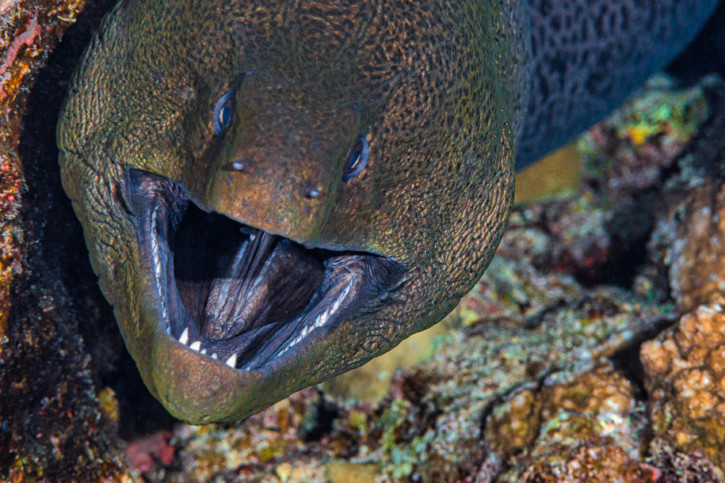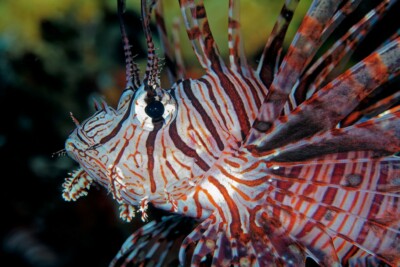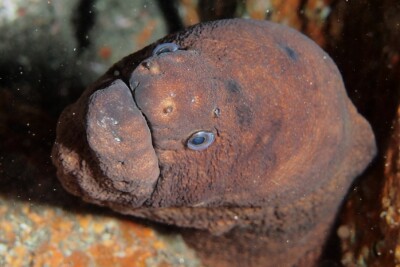Introduction
Gymnothorax javanicus, commonly known as giant moray, is a salt water fish.
This sheet is currently being prepared. The texts currently proposed come from our data model or are being drafted. To request priority for this content, you can write to us HERE.
Who is it?
Morphology
-
Type
-
Average size230 cm
-
Maximum size300 cm
-
Longevity30 year
-
Mimicryrocky bottoms
-
Patternponctuations
-
Type
-
Average size230 cm
-
Maximum size300 cm
-
Longevity30 year
-
Mimicryrocky bottoms
-
Patternponctuations
How to recognize This fish ?
The giant moray measures between 230 and 300 cm. This fish is bicolore with a predominantly noir and marron body. The also has noir ponctuations.
Behaviour & Life cycle
-
dietcarnivorous
-
Sociabilitysolitary
-
territorialYes
-
Way of livingnocturnal
The giant moray hunts in the stalk and is one of the predators of its biotope. Opportunistic, it does not hesitate to attack any smaller animal nearby.
The giant moray is a fish solitary naturally found near the rocks. This species is carnivorous . This fish lives mainly at night. Usually, it leaves its hiding place and starts to be active once it gets dark.
The giant moray is a territorial animal that does not tolerate any incursions into its living area. It is particularly virulent against other territorial species and it can provoke heated fights.
Reproduction
-
Reproductionovipare qui pond en eau libre
The giant moray is a fish ovipare qui pond en eau libre.
Risks for humans
-
VenomousNo
-
BiteYes
This species can attack if it feels threatened. It is important to be particularly vigilant especially during dives or fishing sessions.
Origin and distribution
What is its habitat?
Natural environment characteristics
-
Temperature24 - 28 °C
-
Depth0 - 50 m
Biotope presentation
The giant moray is most often found at a depth between 0m and 50m. However, it is not impossible to find this species at other depths.
Species of the same biotope
To go further
Sources & Contributions
Participation & Validation
The Fishipedia team and specialist contributors are committed to providing high-quality content. However, although the information comes from scientific sources or testimonials from specialists, the cards may contain inaccuracies.
Translation
Translation done with the valuable contribution of our translators, who make this information available to a wider audience. We sincerely thank them for their commitment.
Bibliographic references
- - GBIF
- - A new species of Short Brown Unpatterned Moray Eel of the Genus Gymnothorax (Anguilliformes: Muraenidae) from the Bay of Bengal - DIPANJAN RAY - ANIL MOHAPATRA - DAVID G. SMITH - ZOOTAXA - 2015.
- - First record of the moray eel Gymnothorax reticularis, Bloch, 1795 in the Mediterranean Sea, with a note on its taxonomy and distribution - NIR STERN - MENACHEM GOREN - ZOOTAXA - 2013.
- - The Moray Eel Fishery in the Seagrass Beds of Siquijor Island, Central Philippines, with Remarks on Two New Philippine Records of the Genus Gymnothorax - BILLY T. WAGEY - ABNER A. BUCOL - VIVIE KATUUK - International Peer Reviewed Journal - 2015.
- - Gymnothorax spp. (Muraenidae) as natural predators of the lionfish Pterois miles in its native biogeographical range - Arthur R. Bos - Ashraf M. Sanad - Khamis Elsayed - Environmental Biology of Fishes - 2017. Volume 100, issue 6
- - Interspecific Communicative and Coordinated Hunting between Groupers and Giant Moray Eels in the Red Sea - Redouan Bshary - Andrea Hohner - Karim At-el-Djoudi - Hans Fricke - PLOS biology - 2006. Volume 4 issue 12
Scientific partners
Tags
#Muraenidae
#Gymnothorax
#barrière de corail
#herbier
#lagon
#récifs extérieurs
#Moray eels
#Bay of Bengal
#Persian Gulf
#Great Barrier Reef
#mer d'Oman
#East China Sea
#Philippine Sea
#Red Sea
#South East Asian Seas
#Indonesian seas
#western Indian Ocean
#Galapagos
#Western Tropical Pacific Ocean
#Bali
#Lombok
#Maldives
#Nusa Penida
#French Polynesia
Species of the same family
Same genus
Species of the same biotope




































